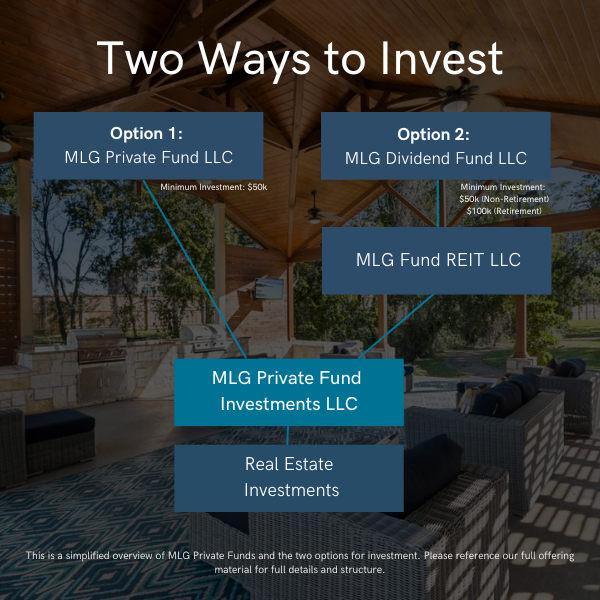Author info
Everyone loves options in life and when you invest in our Private Real Estate funds, you can choose from two Fund options to best suit your personal objectives. When Private Fund IV launched in 2018, we introduced a new concept, “the Dividend Fund” as we’ve called them, in conjunction with our historic fund offerings.
We’re excited to continue offering this dual structure for investors in our latest funds. While both fund options invest in the same underlying assets across each Fund, both fund options present different tax implications to investors. Let’s take a deeper dive.
Why two fund options?
One of the primary reasons we created the Dividend Fund structure was to better accommodate tax-advantaged accounts (i.e., IRAs, 401(k)s, etc.). Without this structure, investors using these types of accounts could face unnecessary tax due to Unrelated Business Taxable Income. UBTI is generally incurred by tax-exempt investors when participating in private real estate funds (in our case) due to the fund utilizing leverage on fund assets. The Dividend Fund structure aims to eliminate the risk of UBTI for investors using tax-advantaged accounts.

What’s the same?
Both fund options invest in the same assets regardless of which option you choose. Similarly, investors in both funds have the same preferred return rate and waterfall structure.
What’s different?
Our MLG Private Fund structure (the “Private Fund”) is a Limited Liability Company that is classified as a partnership for tax purposes. This allows taxable income and loss to pass through to the investors. A primary focus of the Private Fund is to achieve geographic diversification, which will likely result in investments in several states. Depending on your individual tax situation, taxable losses that are passed through may be powerful, especially if they can be used to offset other passive income generated by the rest of your portfolio. Because of the investments in many states, however, you will most likely be obligated to file non-resident state tax returns in many of the states that the Fund is invested in. For an investor who does not have income in multiple states already, or who may be allocating a smaller amount, the additional tax preparation cost could impact returns.
The MLG Dividend Fund structure (the “Dividend Fund”) is also a Limited Liability Company that is classified as a partnership for tax purposes; however, the Dividend Fund intends to own substantially all its investments through a subsidiary REIT which acts as a UBTI blocker. This allows you to invest without incurring Unrelated Business Taxable Income. It can also eliminate non-resident state tax filings, except for the state of Wisconsin. The trade-off with this option, in contrast to the Private Fund, is that the passive losses produced from the Fund’s investments do not pass through to the investor.
What should I be thinking about?
When considering your investment options, we’d strongly encourage you consult with your tax professional to see what makes the most sense for your situation. Here are a few questions you can start with:
- Am I intending to use a retirement account to invest?
- Do I have other sources of passive income that can be offset with potential passive losses generated by the Private Fund structure?
- How much am I investing?
- How much would filing in multiple states cost and what is the impact based on my investment amount?
- Am I intending to invest in more private real estate funds over time?
Ready to invest? Visit our Private Fund page to learn more! If you’re a current investor, you can log in here.
Steve Kelly is Vice President of Investor Relations, and works with the investors in MLG’s various funds. Outside of the office, he enjoys golf, playing guitar, and all the ups and downs of cheering for Wisconsin sports teams.
This blog and associated materials are being presented for informational purposes only and is not an offer to sell interests in a security. A private real estate investment is subject to risks and uncertainty many of which are not outlined herein including, without limitation, risks involved in the real estate industry such as market, operational, interest rate, occupancy, inflationary, natural disasters, capitalization rate, regulatory, tax and other risks which may or may not be able to be identified at this time and may result in actual results differing from expected. Private investments are highly speculative, illiquid, may involve a complete loss of capital, and are not suitable for all investors. Prospective investors should conduct their own due diligence and are encouraged to consult with a financial advisor, attorney, accountant, and any other professional that can help them to understand and assess the risks associated with any investment opportunity.
Past performance is not indicative of future results. Securities offered through North Capital Private Securities, member FINRA/SIPC. Advisory services offered through MLG Fund Manager LLC, an investment adviser registered with U.S. Securities & Exchange Commission.

